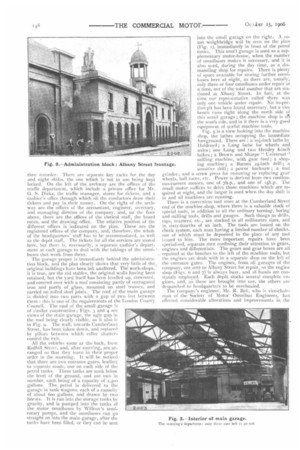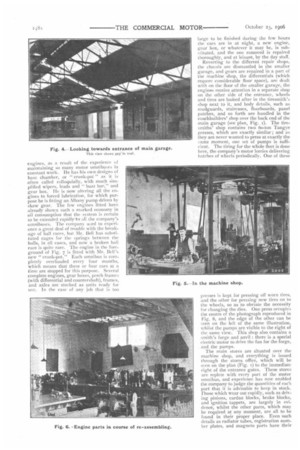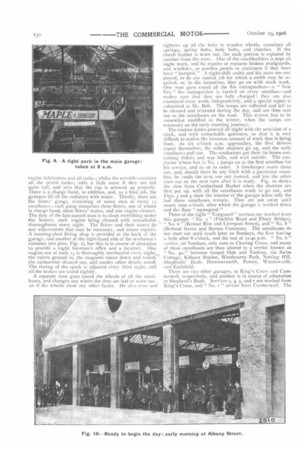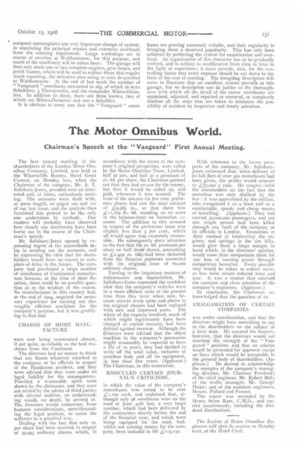Public Service Garages (New Series): " Vanguard."
Page 3

Page 4

Page 6

Page 7

Page 8

Page 9

If you've noticed an error in this article please click here to report it so we can fix it.
The London Motor Omnibus Company, Limited, was the first company to operate motor omnibuses, on a large scale, in London, though it is true that there were a few singledeck omnibuses at work, and two "double-deckers," before the "Vanguard "omnibuses made their appearance. Great interest attaches to the first " Vanguard " garage, for the above reason, and because this company had to discover every detail of organisation for itself, having, naturally, no precedent to guide it. The site selected for the first garage was Booth's Distillery, in Albany Street, Regent's Park. The front block of this distillery (see Fig. 2) was originally built as part of the military hospital, in connection with the Vorse Guards' Barracks, in Albany Street. Hence the solidity of its appearance, and the peculiar style of architecture. The buildings included administration offices, stables, and a large yard, covering, altogether, three-quarters of an acre. The distillery had been unused and unoccupied for three years, and the London Motor Omnibus Company thus secured an excellent site and administration buildings as its headquarters, together with a shell that it could fit up internally to suit its special requirements. The managing director of the company, Mr. Clarence Freeland, possessed considerable experience as to the likely requirements of the contemplated developments, from his connection with the Hastings service, as he resigned the management of that company in order to accept his present appointment. Plans were at once prepared for covering in the whole yard, altering the stables into workshops, and fitting up the stores and fuel reservoirs. Fig. i is a plan of the garage, from which it will be seen that the administration buildings occupy a considerable frontage towards Albany Street, and an archway will be noticed in the middle of this frontage, through which the workmen enter and leave. As they pass through they " clock " themselves, in or out, on a Bundy time recorder. There are separate key racks for the day and night shifts, the one which is not in use being kept locked. On the left of the archway are the offices of the traffic department, which include a private office for Mr. G. S. Dicks, the traffic manager, stores for tickets, and a cashier's office through which all the conductors draw their tickets and pay in their money. On the right of the archway are the offices of the accountant, engineer, secretary. and managing director of the company, and, on the floor above, there are the offices of the clerical staff, the' board room, and the drawing office. The relative position of the different offices is indicated on the plan. These are the registered offices of the company, and, therefore, the whole of the headquarters' staff has to be accommodated, as well as the depot staff. The tickets for all the services are stored here, hut there is, necessarily, a separate cashier's department at each garage to deal with the takings of the omnibuses that work from them.
The garage proper is immediately behind the administration block, and the plan clearly shows that very little of the original buildings have been left unaltered. The work-shops, it is true, are the old stables, the original walls having been retained, but the yard itself has been levelled up, concreted, and covered over with a roof consisting partly of corrugated iron and partly of glass, mounted on steel trusses, and carried on rolled steel joists. The roof of the main garage is divided into two parts with a gap of two feet between them : ibis is one of the requirements of the London County Council. The roof of the small garage is of similar construction ; Figs. 3 and 4 are views of the main garage, the ugly gap in the roof being clearly visible, as it also is in Fig. 9. The wall, towards Cumberland Street, has been taken down, and replaced by pillars between which roller shutters control the exit.
All the vehicles enter at the back, from Redhill Street, and, after entering, are arranged so that they leave in their proper order in the morning. It will be noticed that there are two entrance gates, leading to separate roads, one on each side of the petrol tanks. These tanks are sunk below the level of the ground, and are two in number, each being of a capacity of 2,500 gallons. The petrol is delivered to the garage in tank wagons, each of a capacity of about boo gallons, and drawn by two horses. It is run into the storage tanks by gravity, and is pumped into the tanks of the motor omnibuses by Willcox's semirotary pumps, and the omnibuses can go straight on into the main garage, after the tanks have been filled, or they can be sent into the small garage on the right. A
ton weighbridge weighbridge will be seen on the plan (Fig. 1), immediately in front of the petrol tanks. This small garage is used as a supplementary motor-house, when the number of omnibuses makes it necessary, and it is also used, during the day time, as a dismantling shop for repairs. There is plenty of space available for storing further omnibuses here at night, as there are, usually, only three or four omnibuses under repair at a time, out of the total number that are stationed at Albany Street. In fact, at the time our representative called there was only one vehicle under repair. No inspection pit has been found necessary, but a vice bench runs right along the north side of this small garage ; the machine shop is A the south side, and in it there is a very good equipment of useful machine tools.
Fig. 5 is a view looking into the machine shop, the lathes occupying the immediate foreground. There are : a to,1-inch lathe by I foldroyd; a Lang lathe for wheels and axles; one Lang and two Hendey 8-inch lathes; a Brown and Sharpe " Universal "
milling machine, with gear feed ; a shaping machine ; a Barnes 25-inch drill ; a sensitive drill; a power hacksaw ; a tool grinder ; and a screw press for removing or replacing gear ivheels, ball races, etc. Power is derived from two continuous-current motors, one of 7h.p., and one of 15h.p. The small motor suffices to drive those machines which are required at night, and the larger is used when the day shift is in and all machines are running.
There is a convenient tool store at the Cumberland Street end of the machine-shop, where there is a valuable stock of special tools, in addition to all the ordinary turning, boring and milling tools, drills and gauges. Such things as drills, taps, reamers, etc., are stocked in all millimetre sizes, and in sixty-fourths of an inch. The tools are issued on the check system, each man having a limited number of checks, one of which must be deposited in the place of any tool issued to him. The more important repairs have been specialised, separate men confining their attention to gears, engines and differentials. The gears and gear boxes are all repaired at the benches to the left of the machine tools, but the engines are dealt with in a separate shop on the left of the entrance gates. The engines, from all garages of the company, are sent to Albany Street for repair, so the engine shop (Figs. 6 and 7) is always busy, and 18 hands are constantly employed. Each depot stocks several complete engines, and, as these are brought into use, the others are despatched to headquarters to be overhauled.
The company's engineer, Mr. R. Bell, who is vice-chairman of the Society of Motor Omnibus Engineers, has effected considerable alterations and improvements in the engines, as a result of the experience of maintaining so many motor omnibuses in constant work. He has his own designs of base chamber, or " crank-pot " as it is often called colloquially, with much simplified wipers, leads and " buzz bar," and gear box. Ile is now altering all the engines to forced lubrication, for which purpose he is fitting an Albany pump driven by skew gear. The few engines fitted have already shown such a marked economy in oil consumption that the system is certain to be extended rapidly•to all the company's omnibuses. The company wed to experience a great deal of trouble with the breakage of ball races, but Mr. Bell has substituted cages for the springs between the halls, in all cases, and now a broken ball race is quite rare. The engine in the foreground of Fig. 7 is fitted with Mr. Bell's new " crank-pot." Each omnibus is completely overhauled every four months, which means that three or four cars at a time are stopped for this purpose. Several complete engines, gear boxes, perch frame:, (with differential and countershaft), frames, and axles are stocked as units ready for use. In the case of any job that is too large to be finished during the few hews the cars are in at night, a new engine, gear box, or whatever it may be, is sub;Littited, and the one removed is repaired thoroughly, and at leisure, by the day staff.
Reverting to the different repair shops, the chassis are dismantled in the smaller garage, and gears are repaired in a part of the machine shop, the differentials (which require considerable floor space), are dealt with on the floor of the smaller garage, the engines receive attention in a separate shop on the other side of the entrance, wheels and tires are looked after in the tiresmith's shop next to it, and body details, such as mudguards, staircases, floorboards, panel patches, and so forth are handled in the coachbuilders' shop over the back end of the main garage (see plan, Fig. 1). The tiresmiths' shop contains two fxrion Tangye presses, which are exactly similar ; and as they are never wanted to press at exactly the same moment, one set of pumps is sufficient. The tiring for the whole fleet is done here, the company 's motor lorries delivering batches of wheels periodically. One of these presses is kept for pressing off worn tires, and the other for pressing new tires on to the wheels, so as to obviate the necessity for changing the dies. One press occupies the centre of the photograph reproduced in Fig. 8, and the edge of the other can be seen on the left of the same illustration, whilst the pumps are visible to the right of the same view. This shop also contains a smith's forge and anvil : there is a special electric motor to drive the fan for the forge, and the pumps.
The main stores are situated over the machine shop, and everything is issued through the stores office, which will be seen on the plan (Fig. 1) to the immediate right of the entrance gates. These stores are replete with every part of the motor omnibus, and experience has now enabled the company to judge the quantities of each part that it is advisable to keep in stock. Those which wear out rapidly, such as driving pinions, cardan blocks, brake blocks, and ignition tappets, are largely in evidence, whilst the other parts, which may be required at any moment, are all to be found in their proper place. Even such details as radiator tubes, registration number plates, and magneto parts have their
place in the pigeon holes. Two frame, are kept complete, and hung up on the wall at the back of the main garage. Two perch .frames are also kept complete, with the differential and counter-shaft on then:. Spare tires are stocked in a room over the running-shed fitting shop, which is divided off from the coachbuilders' shop. Whee.s are always re-tired, or otherwise repaired, immediately they are taken off, and then are ranged against the wall in the main garage, under a board inscribed " Wheel ready for the road." The oil stores are part of the main building, and comprise three large tanks, sunk two feet into the ground, containing, respectively, castor oil, engine oil, and gear oil. The barrels are run up on ladders and stood, bung downwards, to drain into the tanks. The tank cover is sunk a foot below the top of the sides, and is perforated to allow the oil to enter. The oil is pumped up from these tanks, and delivered through ashort hose into a travelling oil tank on four wheels, in which it is taken to each omnibus. Separate "cabinet " tanks to hold paraffin, for head and tail lamps, etc.,
are also kept in this store.
The chief engineer of the company courteously afforded our representative an opportunity of seeing the routine which has to be observed every night to prepare the vehicles for the next day's work. The omnibuses begin to arrive at the garage shortly after o'clock, and are stopped outside by two men, one of whom removes the carbide cartridges from the acetylene generator, and thus extinguishes the four interior lamps, while the other extinguishes the paraffin headlights and the tail lamp. This is done to obviate all risk of fire when the petrol tanks are being filled. it is thought safer to tell off special men for this work, than to entrust it to the driver and conductor. The omnibuses are then driven in through one of the entrance gates, and stopped in the open yard, and the conductor goes off to the cashier's office and pays in the money taken during the day ; he also reports any lost time, or other incidents. The petrol tanks are at once filled, a man being stationed at the pump of the petrol storage tank, from which a long hose is led to each omnibus. Four omnibuses can be filled at a time, and the whole of the open yard is plentifully sprinkled with sand, to absorb any petrol that may be spilled during these operations. The driver remains with his omnibus, and as soon as the petrol tank is filled he drives it on into the garage, placing it where directed by the foreman. He then removes his hooter and goes home. An almost unique arrangement obtains in this company's working : it is the issuing of a horn to each driver, instead of to each omnibus, and the stamping the number of the driver's police badge on the metal portion. Although this means double the number of horns, because of the relief drivers, it has proved much more economical. The appearance of the garage, when all the omnibuses are in, can be gauged from the photograph reproduced as Fig. 9. The vehicles are arranged in the order in Which they arp due out in the morning, the earliest near to the Cumberland Street gates. First, there are eight rows, four deep; next there are three ranks crosswise, as can be seen in the foreground of Fig. 9, with three in each rank ; and then there is .pranother rank at the extreme back, facing towards Cumberland Street, containing eight omnibuses, and a further four omnibuses can be placed under the coachbuilders' shop. The smaller garage has room for four rows, three deep, making a total of 65 for the Albany Street depot.
. The garage is lighted by double-enclosed arc lamps, and these have been very carefully placed, so that an arc lamp comes between each two bonnets : this secures a splendid degree of illumination for engine cleaning and adjusting. Similarly, there is a hanging plug, for inspection lamps, for each two omnibuses. There is, also, a special shop over the end of the small garage in which attention is given to the electric lights; it will be readily understood that the efficiency of the night work largely depends on good lighting. The cleaning and repairing is divided
into several distinct classes of work, each. with its separate staff of workmen.. Firstly, there are the washers, who wash all the mud all the wheels and under parts,. and clean the interior and exterior of everyomnibus : the washers work in gangs of four to each nine omnibuses, one of the four taking the special work of brushing out the interior, and the top deck, and polishing the windows and brass work. Secondly, the greasers work in one gang for the whole garage : the first duty of the greasers is to fill the petrol tanks as the (Minibuses come in, and they are all occupied with this work until after one o'clock a.m. They then start their other duties, each man on his allotted task : one goes round all the wheel caps and fills them with castor oil ; another cleans and fills all' the drivers' oil cans ; a third fills all the. Stauffer grease lubricators; another cleans and replenishes the differentials and gear boxes; a fifth sees to all the cardan joints, and. then helps with. the gear boseF,; the sixth fills up all the
s, en,r ' engine lubricators and oil tanks whilst the seventh examines •
all the petrol tanks; adds a little more if they are not quite full, and sees that the cap is screwed up properly. There is a charge hand, in addition, and, as a final job, the greasers fill all the radiators with water. Thirdly, there are the fitters' gangs, ccnsistingof seven men to every 13 omnibuses; each gang comprises three fitters, one of whom is charge hand, three fitters' mates, and one engine cleaner. .The duty of the last-named man is to clean everything under the bonnet, each engine being cleaned with remarkable thoroughness every night. The fitters and their mates do any adjustments that may be necessary, and minor repairs. A running-shed fitting shop is provided at the back of the garage, and another at the right-hand side of the workmen's .'entrance (sec plan, Fig. 1), but this is in course of alteration to provide a night foreman's office and a lavatory. One engine out of each 13 is thoroughly overhauled every night, _ the valves ground in, the magneto taken down and tested, the carburetter cleaned out, and sundry other details noted. The timing of the spark is adjusted eery third night, and all the brakes are tested nightly.
A separate man goes round the wheels of all the omnibuses, and changes any where the tires are bad or ‘vorn out, or if the wheels show any other faults. He al:A) tests and
tightens up all the bolts in wooden wheels, examines all springs, spring bolts, body bolts, and clutches. If the clutch leather is worn out, the male portion is replaced by another from the store. One of the coachbuilders is kept on night work, and he repairs or replaces broken mudguards, and windows, or patches panels or staircases if they have been " bumped." A night-shift smith and his mate are employed, to do any special job for which a smith may be required, or, in the meantime, they go on with stock work. One roan goes round all the fire extinguishers—a " New Era " lire extinguisher is carried on every omnibus—and makes sure that they are fully charged : they are also examined every week, independently, and a special report is submitted to Mr. Bell. The lamps are collected and left to be cleaned and trimmed during the day, and are then sent out to the omnibuses on the road. This system has to be somewhat modified in the winter, when the lamps are necessary on the early morning
journeys.
The routine duties proceed all night with the precision of a clock, and with remarkable quietness, so that it is very difficult to realise the immense amount of work that is being done. As six o'clock a.m. approaches, the first drivers report themselves, the roller shutters go up, and the early omnibuses pull out. The conductors get their tin boxes containing tickets and way bills, and wait outside. The conductor whose box is No. i jumps on to the first omnibus for his service, and so on in order. A timekeeper starts them out, and, should there be any hitch with a particular omnibus, he sends the next one out instead, and lets the other start out on the next turn after it is ready. Fig. to shows the view from Cumberland Market when the shutters are first put up, with all the omnibuses ready to go out, and Figs. 3 and 4 show the interior of the garage when only the last three omnibuses remain. They are not away until nearly nine o'clock, after which the garage is washed down and the floor " squeegeed." Three of the eight " Vanguard " services are worked from this garage-` No. a " (Einchley Road and Ebury Bridge), " No. 6 " (Kensal Rise and Liverpool Street), and " No. 8 " (Bethnal Green and Barnes Common). The omnibuses do not start out until much later on Sundays, the first leaving a little after 8 o'clock, and the last at 12.40 p.m. " No. 6 " service, on Sundays, only runs to Charing Cross, and many of these omnibuses-are then altered to a service known as " No. 4a," between Gospel Oak and Tooting, via Swiss Cottage, Kilburn Station, Westbourne Park, Notting Hill, Shepherds' Bush, Hammersmith, Putney, 'Wandsworth, and Earlsfield.
There are two other garages, at King's Cross and Camberwell, respectively, and another is in course of adaptation at Shepherd's Bush. Services 3, 4, 5. and 7 are worked from King's Cross, and " No. / " service from Camberwell. The company contemplates one very important change of system, in separating the principal repairs and extensive overhauls from the running department. Large workshops are in course of erection at Walthamstow, for this purpose, and much of the machinery will be taken there. The garage will then only stock one or two complete engines, gear boxes, and perch frames, which will be used to replace those that require much repairing, the defective ones being at once despatched to Walthainstow. At the end of last week the number of " Vanguard " omnibuses amounted to i6s, of which xfi were Scheiblers, 3 Thornycrofts, and the remainder Milnes-Daimlers. In addition to these, there are three lorries, two of which are Milnes-Dahnlers and one a Scheibler.
It is obvious to every one that the "Vanguard " omni buses are proving extremely reliable, and their regularity is bringing them a deserved popularity. This has only been achieved by perfecting the system for examination and overhaul. An organisation of this character has to be gradually evolved, and is subject to modification from time to time in the light of experience; it must provide, also, for the controlling factor that every expense should be cut down to the limit of the cost of running. The foregoing description will serve to illustrate that an excellent system prevails at this garage, but no description can do justice to the thoroughness with which all the detail of the motor omnibuses are examined, adjusted, and repaired or renewed, or completely disclose all the steps that are taken to minimise the pos
sibility of accident by inspection and timely attention. •
























